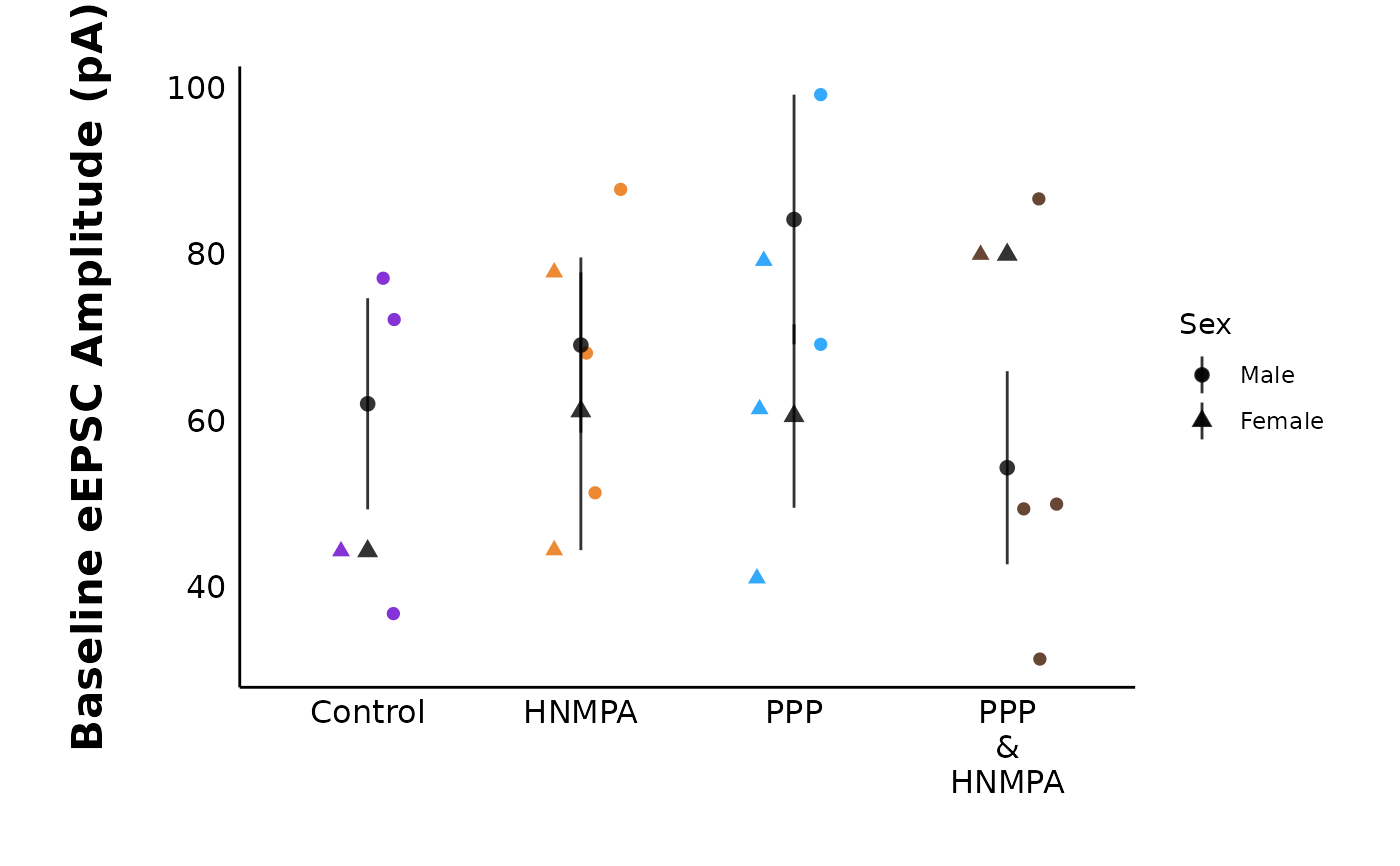This function creates a scatterplot of y_variables such as raw amplitude
grouped according to treatment. The data are limited to values from the
baseline period, allowing for a quick comparison of baseline parameters
across treatments. For evoked currents, only raw amplitude is available for
comparison. For spontaneous currents, raw amplitude and raw frequency during
the baseline period can be plotted.
Usage
plot_baseline_data(
data,
current_type = "eEPSC",
plot_category,
y_variable = "raw_amplitude",
include_all_treatments = "yes",
list_of_treatments = NULL,
baseline_interval = "t0to5",
filename_suffix = "",
large_axis_text = "no",
included_sexes = "both",
male_label = "Male",
female_label = "Female",
plot_width = 8,
treatment_colour_theme,
theme_options,
save_plot_png = "no",
ggplot_theme = patchclampplotteR_theme()
)Arguments
- data
A dataframe containing the summary data generated from
make_summary_EPSC_data(). Ifcurrent_typeis "eEPSC", this must be the$summary_dataelement of the list produced bymake_summary_EPSC_data().- current_type
A character describing the current type. Allowed values are
"eEPSC"or"sEPSC".- plot_category
A numeric value specifying the category, which can be used to differentiate different protocol types. In the sample dataset for this package,
plot_category == 2represents experiments where insulin was applied continuously after a 5-minute baseline period.- y_variable
A character describing the parameter used on the y-axis. If
current_type == "eEPSC", the allowed y_variable is"raw_amplitude". Ifcurrent_type == "sEPSC", the allowed y_variables are"raw_amplitude"or"raw_frequency". Note: It does not make sense to use normalized/baseline transformed amplitudes, since these will all be 100, and the graph will be a flat line.- include_all_treatments
A character (
"yes"or"no") specifying if the plot will include data from all treatments. If"no", you must specify a list of treatments inlist_of_treatments.- list_of_treatments
A list of character values describing the treatments that will be in the plot. Defaults to
NULL, since include_all_treatments is"yes"by default.- baseline_interval
A character value indicating the name of the interval used as the baseline. Defaults to
"t0to5", but can be changed. Make sure that this matches the baseline interval that you set inmake_normalized_EPSC_data().- filename_suffix
Optional character value to add a suffix to the filename of the .png file created with this plot. Could be useful if you have specified a custom list of treatments.
- large_axis_text
A character (
"yes"or"no"). If"yes", a ggplot theme layer will be applied which increases the axis text.- included_sexes
A character value (
"both","male"or"female"). Useful if you want to have a plot with data from one sex only. Defaults to"both". If you choose a single sex, the resulting plot will have"-males-only"or"-females-only"in the file name.- male_label
A character value used to describe how males are encoded in the
sexcolumn of the dataframe used indata. This MUST match the value for male data in thesexcolumn, and it must be consistent across data sheets. Defaults to"Male".- female_label
A character value used to describe how females are encoded in the
sexcolumn of the dataframe used indata. This MUST match the value for female data in thesexcolumn, and it must be consistent across data sheets. This must be consistent in all data sheets. Defaults to"Female".- plot_width
A numeric value specifying the width of the plot. Defaults to 8, but you will need to adjust this depending on how many treatments you have.
- treatment_colour_theme
A dataframe containing treatment names and their associated colours as hex values. See sample_treatment_names_and_colours for an example of what this dataframe should look like.
- theme_options
A dataframe containing theme options, defaults to
sample_theme_options. See sample_theme_options for an example of what this dataframe should look like and how you can customize these values.- save_plot_png
A character (
"yes"or"no"). If"yes", the plot will be saved as a .png usingggsave(). The filepath depends on the current type, but they will all go in subfolders belowFigures/in your project directory.- ggplot_theme
The name of a ggplot theme or your custom theme. This will be added as a layer to a ggplot object. The default is
patchclampplotteR_theme(), but other valid entries includetheme_bw(),theme_classic()or the name of a custom ggplot theme stored as an object.
Value
A ggplot object. If save_plot_png == "yes", it will also generate
a .png file in Figures/Evoked-currents/Output-summary-plots or
Figures/Spontaneous-currents/Output-summary-plots. The .png filename will
contain the y_variable.
Examples
plot_baseline_data(
data = sample_summary_eEPSC_df$summary_data,
current_type = "eEPSC",
plot_category = 2,
y_variable = "raw_amplitude",
include_all_treatments = "yes",
list_of_treatments = NULL,
baseline_interval = "t0to5",
included_sexes = "both",
large_axis_text = "no",
plot_width = 8,
treatment_colour_theme = sample_treatment_names_and_colours,
theme_options = sample_theme_options,
save_plot_png = "no"
)
#> Warning: Removed 2 rows containing missing values or values outside the scale range
#> (`geom_segment()`).

